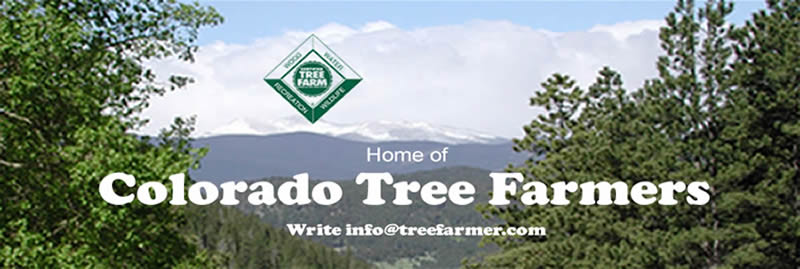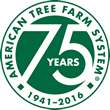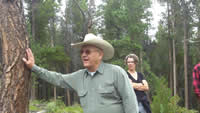| Be confident that what you do in your forest will improve it's health and sustainability for future generations. Become a Tree Farmer! |
|||
| Tree Farmer Alert | |||
| Wednesday, January 25, 2016 Over 800 readers and growing! |
|||
2016 Colorado Tree Farmer of the Year |
|||
Every year the Colorado Tree Farmers award a Tree Farmer of the Year designation to a Tree Farmer who has done an outstanding job managing their woods to improve forest health. The award is not only an opportunity to recognize exceptional effort by an idividual or family but an opportunity to educate, inspire, and motivate other forest landowners to improve the health of their woods. Award recipients conduct a tour of their Tree Farm, showcase the work accomplished and answer questions. Foresters and other forestry experts are also in attendance to provide insight into best practices for forest management. In 2016 Tom Fey, his wife Gaylene, and family received the award. Periodically we announce tours of well managed properties. The public is always invited and encouraged to attend, ask questions and meet landowners committed to improving the health of their forests. Check out all our outreach activities at TreeFarmer.com Here is a link to a short video of our 2016 Tree Farmers of the Year. View video |
|||
Lichens are an early warning system for forest healthFrom ScienceNews |
|||
“Where there is pollution, there is a predictable effect on lichens,” Geiser says. Rare and delicate lichen species that are highly specialized to their habitat are some of the first to die out as air quality falls. Less-sensitive, generalist lichens hang on longer and, in some cases, even survive and expand. Both can signal problems to come.
|
|||
'Forest Bathing' — the Japanese ritual that science suggests could reduces stressfrom Business Insider |
|||
Hear the phrase "forest bathing" and you might imagine a group of open-minded hippies showering under waterfalls or rolling in muddy pools of water.
|
|||
Conifer Seed Bugscontributed by Steve Goodroad, Tree Farmer |
|||
We have been invaded by these things this year. I don't know if they are harming the trees or are just a nuisance. I have attached some info on the bug. I was wondering if others are enjoying these insects too. Thanks, Steve
|
|||
Wood Tech Offers Hope for Struggling Timbercontributed by Nicki Rutt, Tree Farmer |
|||
Visually blemished wood that currently goes to waste can be used in the middle layers of a CLT panel without sacrificing strength or look. Supporters say it could bring sawmills back online while improving forest health through thinning dense stands and making use of low-value wood and local tree species. Trees as small as 5 inches in diameter at the top and those damaged by pests and wildfire are prime candidates.
|
|||
CorrectionFrom Molly Pitts |
|||
Due to some confusion on my part, some of the numbers previously presented were not correct. (Healthy Forests article 01/05/17) The numbers have since been corrected and I really apologize for any confusion.
|
|||
|
|
|||
Feedbackfrom Bruce Benninghoff |
|||
Two of these articles raise an issue. (Tree Farmer Alerts 01-05-17) Is there a place, or maybe even an editorial obligation, to put 'news' into the context of reality?
The article "Forest health in US can affect trees in Siberia"
"The researchers ran a climate model with a drastic forest-loss scenario to investigate the most extreme potential climate effects."
The context is:
There are many climate models, this research used one. Can they arrive at similar conclusions with other models?
They had to use a 'drastic' forced input to get any newsworthy results.
"Forest loss is known to have a nearby cooling effect, because without trees the Earth’s surface is more reflective and absorbs less sunlight, and loss of vegetation also makes air drier. These local effects of deforestation are well known."
Is the notion that deforestation leads to cooling a universally accepted phenomenon?
Someone in the science community once said "All models are wrong, but some can be useful."
These factors/questions should always be kept in mind when delivering these messages to the public.
Too many people just accept this as gospel without applying a healthy dose of skepticism or critical thinking.
The article "The Science Of Wildfires May Be Up In Smoke" is another example where the info, as portrayed, seems a bit simplified to be the basis of the decisions implied.
One only has to pay attention to the fire in the fireplace or a campfire to realize that variables like the fuel moisture content, the combustion temperature and the availability of oxygen will yield very different chemical components in the smoke.
Does the research, as presented, represent a valid basis for decision making? Hopefully, the final results will be put in an appropriate context when published.
Many times such research only serves to identify areas that need more research or some other type of validation.
I ask the initial question because I wondered about the editorial freedom vs responsibility when I added such stuff to the Colorado Forestry Assoc. website.
I may have been guilty of not adding any context there.
I ask because the whole issue of the validity and value of what gets "published" on the web is a growing question.
What degree of freedom and responsibility do 'publishers' and 'editors' have?
Bruce Benninghoff
|
|||
If this email was helpful,
|
|||



 the road, behind the green and white Tree Farm signs and we care about what's happening in our forests.
the road, behind the green and white Tree Farm signs and we care about what's happening in our forests.
